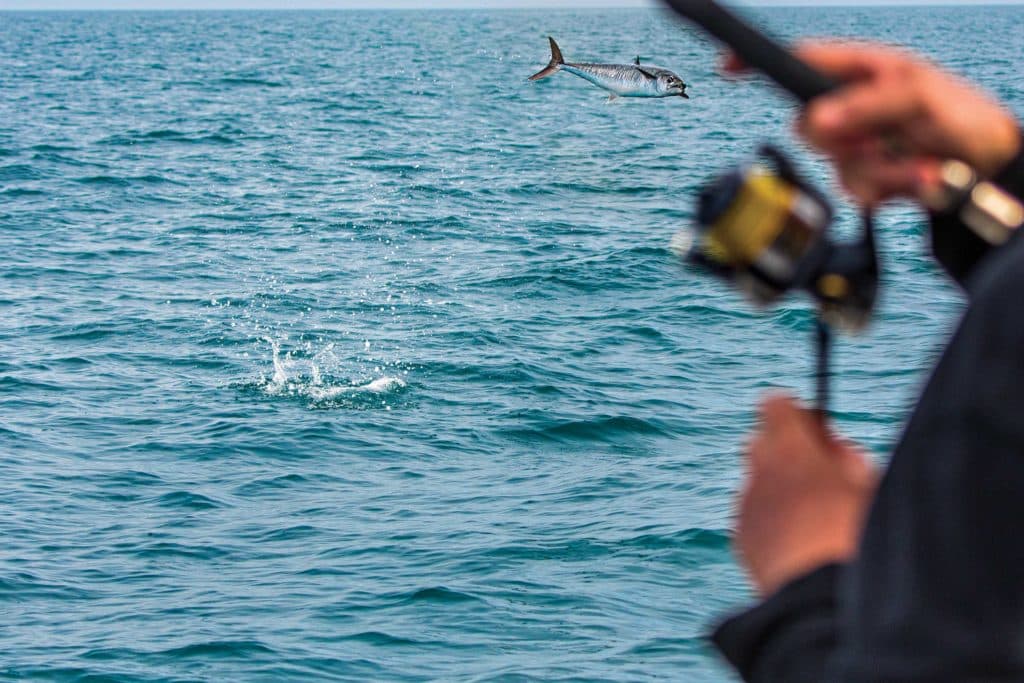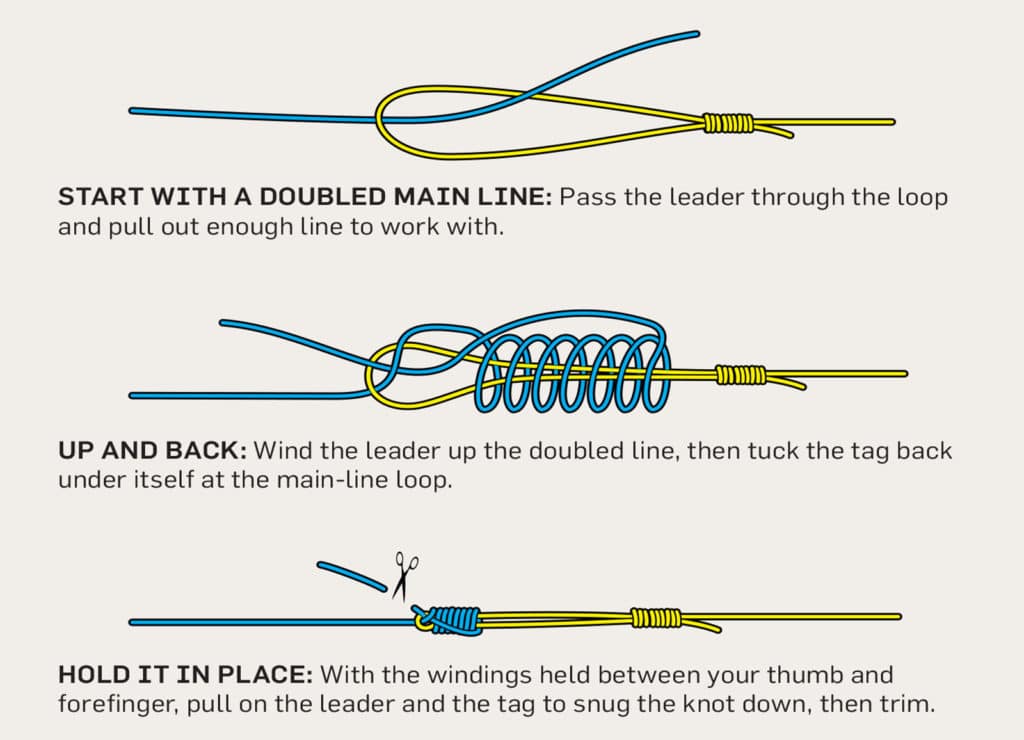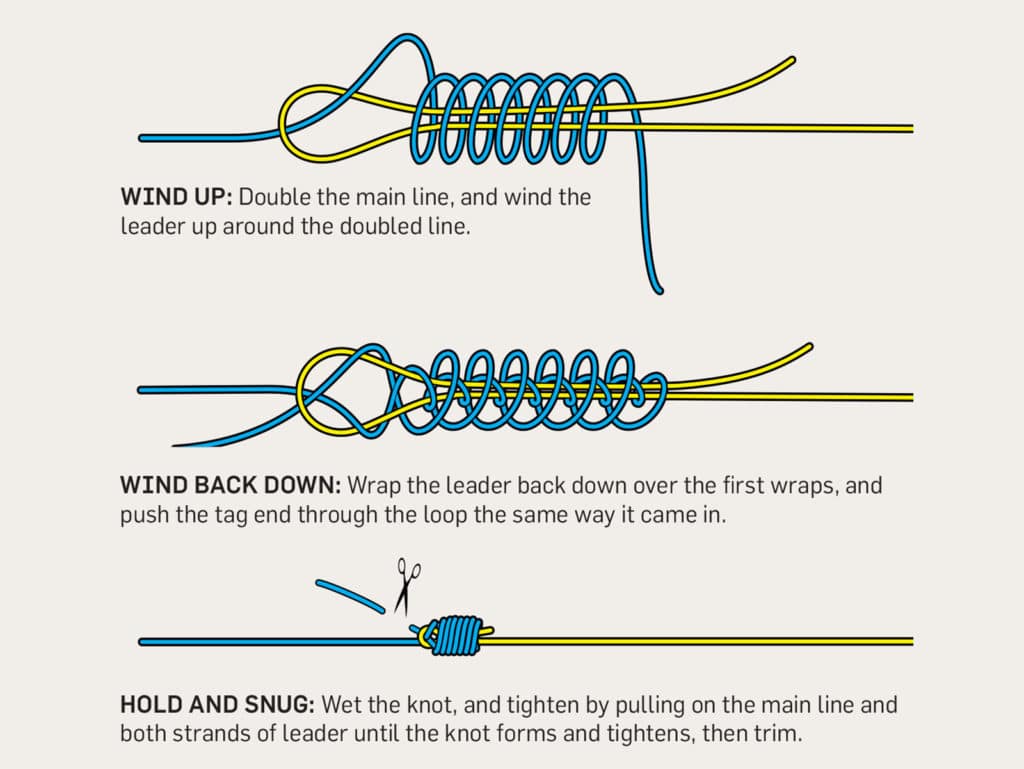
There are several standout fishing knots and connections that excel at joining the main fishing line to a leader, a few of which migrate from fresh water all the way out to the Gulf Stream and offshore canyons.
In most cases, the line-to-leader knots and connections are developed to achieve specific goals outside of simply joining two lines. For example, there are performance knots that minimize the slicing tendencies of braid against monofilament. Then there are those that yield superior strength, enhance long distance casting and, of course, can be quickly and effortlessly tied on the spot, even on a rocking boat or in low light.
Below are tried-and-true performance line-to-leader connections and their advantages. Included is one of my favorites: the Bristol knot. If your most cherished line-to-leader knot isn’t among these four, there’s a good chance it’s outlined in detail at saltwatersportsman.com/fishing-knots-videos.
Bristol Knot
This is the quintessential light-tackle wind-on leader connection, which utilizes a Bimini twist (double line). It’s ideal for joining a mono or braid main line to a mono or fluorocarbon leader.
The Bristol knot dates back to line-class record-seekers. Their goal: to gain an advantage by winding a long, heavy leader back onto the reel to shorten the fight. This knot passes easily through rod guides and spinning reel rollers.

I use the Bristol knot to join 15 feet of 30-pound fluoro leader to 12- and 20-pound mono when kite-fishing; to join 40 feet of 30-pound fluoro leader to 20-pound mono when drifting deep baits for tuna and dolphin; and to join 3 feet of 25- or 30-pound fluorocarbon leader to 10- and 20-pound braid on spin tackle for trout, snook and reds. It’s especially useful on light tackle because it retains 100 percent strength.
The Bristol is every bit as excellent at joining braid-to-mono and fluorocarbon as it is for joining mono lines to mono and fluorocarbon leaders.
The only tweak required to neutralize the cutting tendency of braid on mono is to double the number of wraps in both the Bimini and Bristol.
Every performance knot has a fatigue factor. After repeatedly passing through rod guides and bail rollers, and due to contact with abrasive structures and stresses associated with extreme fish fights, these knots wear and, when left unchecked, can fail.
The Bristol knot is no exception. I’ll retie it at least once during the day under active casting situations. And you can bet your last dollar that all my fishing knots are retied prior to any new outing.
Improved Albright
This knot is easy to master, maintains a 100 percent connection strength, and effortlessly passes through rod guides and bail rollers. The Improved Albright joins two single strands of line without a knot doubling the main line. It’s also a solid connection for joining mono lines to mono or fluoro leaders, and braid to mono or fluoro leaders as heavy as 80-pound-test.
The original Albright Special was an early favorite of mine for joining mono lines to heavy leaders, including wire. For example, I used the Albright Special in lieu of a small swivel when adding a short trace of wire to a light mono leader for live-baiting and jigging up king mackerel.

The Albright Special is a strong short-leader connection, but it’s generally too stiff and bulky to pass through rod guides and bail rollers.
The Improved Albright or Alberto knot is not lacking in controversy. “I developed the Alberto knot for joining braid to a mono or fluoro leader,” says Alberto Knie, an ardent surf-caster and trophy-fish specialist.
“My knot is 100 percent strong, won’t cut through mono or fluoro, and can be tied in less than 15 seconds. The more you pull, the tighter it becomes. It’s an exceptional knot benefiting anglers seeking to attach a mono top shot or long leader to braid line.
“Mr. Albright wrote me, saying I copied his Improved Albright knot,” Knie says. “However, they’re not the same. The Improved Albright is primarily a mono-to-mono knot; mine is primarily a braid-to-mono knot. There are differences. Plus, I created this knot back in the early years of braid, around 10 years prior to the Improved Albright. Fenwick’s Iron Thread was the first braid line marketed to recreational anglers. I surf-fished, but the 125 yards that came on each spool wasn’t enough for long-distance casting. Therefore, I played with knots to join that 125-yard section of braid to mono line in order to fill my reel spool for maximum casting distance, and to keep the braid from damaging and cutting the monofilament at the connection, which was an issue during those early days.
“I wrote back to Mr. Albright and asked if his original knot was so good, why did he have to improve it?”
Uni-to-Uni
A knot that maintains roughly 90 percent of the breaking strength, the uni-to-uni connection is a popular choice for joining mono lines to mono and fluorocarbon leaders, or braided lines to mono and fluorocarbon leaders.
Its advantage, outside of the ease in tying it, is the relatively small connection that results after snugging down the individual knots.
The uni-to-uni is popular for putting backing line on reels because the small connection lies down nicely.
Though this knot isn’t quite as diminutive as the Bristol, with the same-strength main line and leader, a uni-to-uni knot also passes through rod guides and bail rollers without issues, provided you use smaller-diameter line and leader. It’s also a dependable choice for heavy leaders.
The uni-to-uni is nearly universal in usage, excelling in backcountry, inshore, and bay, coastal and even offshore fishing scenarios.









